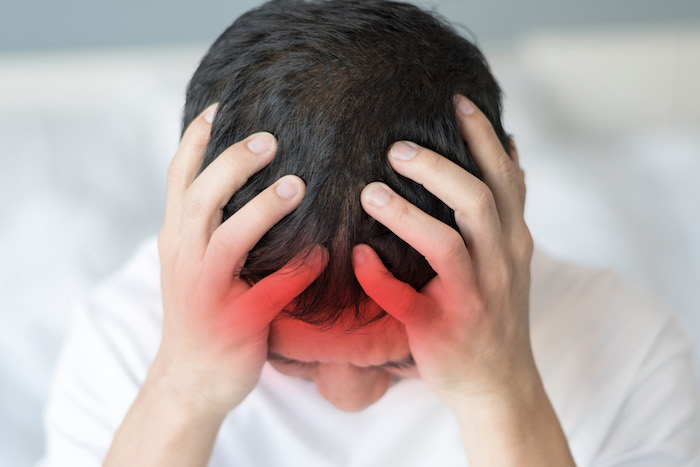
Headaches are a common health problem that most people experience at some time.
Factors that lead to headaches may be:
- emotional, such as stress, depression, or anxiety
- medical, such as migraine or high blood pressure
- physical, such as an injury
- environmental, such as the weather
Frequent or severe headaches can affect a person’s quality of life. Knowing how to recognize the type of headache and its cause can help a person take appropriate action.
Some of the various kinds of headaches include:
Tension-type headache (TTH) - This is the most common form of headache, affecting three-fourths of the general population. Tension-type headache was previously called muscle contraction headache. It is associated with the muscles of the neck, face, and jaw.
A 2020 study found that TTH is closely related to stress.
A person with TTH may feel:
- as if they have a tight band around their head
- a constant, dull ache on both sides of the head
- pain spreading to or from the neck
Tension-type headaches may be episodic or chronic. Serial attacks usually last for a few hours, though they can last for several days. When TTHs occur on 15 or more days per month for at least 3 months, they are considered chronic.
Migraine - Migraine is the third most common and the seventh most disabling illness globally. Based on a 2021 survey, it affects almost 16% of the U.S. population.
A migraine headache may involve pulsating, throbbing pain. It often occurs on one side of the head but may switch sides.
During an episode, a person may also experience:
- lightheadedness
- sensory disturbances, such as changes in vision, known as an aura
- sensitivity to light or sound
- nausea, possibly with vomiting
Migraine headaches are the second most common form of primary headache after TTH. They can significantly impact the quality of life.
A migraine episode may last from 4–72 hours when untreated or unsuccessfully treated. The frequency of episodes can vary greatly, but many people have two to four migraine episodes in a month.
Medication overuse headache (MOH) - Also known as rebound headaches and medication-misuse headaches, this type occurs in people who take medications to treat their headaches too often.
People with primary headache disorders like migraine often develop medication overuse headaches. These can cause migraine episodes to occur more frequently and become more severe.
Instead of alleviating symptoms, the medications cause headaches and increase their intensity and frequency. MOHs tend to result from taking opiate-based medications, such as those that contain codeine or morphine.
Beyond the headache, a person may experience:
- neck pain
- restlessness
- a feeling of nasal congestion
- reduced sleep quality
The location, severity, and frequency of MOHs vary from person to person, but they often occur daily or nearly daily and are present upon waking up. MOH can cause dull pain like a tension headache to more severe pain similar to a migraine headache.
Cluster headaches - These headaches usually last between 15 minutes and 3 hours, and they may occur one to eight times per day.
Cluster headaches may frequently arise for 4–12 weeks, then disappear. They tend to happen at around the same time each day.
Between the clusters, the person may have no symptoms. These remission periods may last months or years.
Cluster headaches often involve brief but severe pain around or behind the eye on one side of the face. This pain can radiate to other parts of the face.
The following may accompany a cluster headache:
- red or watery eyes
- drooping or swollen eyelids
- blocked or runny nose
- a smaller pupil (constricted) in one eye
- sweating on the forehead
Thunderclap headaches - These are sudden, severe headaches that people often describe as the worst headache of their lives. They reach maximum intensity in about 30 seconds to a minute and slowly fade within a few hours.
A thunderclap headache is a secondary headache that can indicate a life-threatening condition, such as:
- an aneurysm
- reversible cerebral vasoconstriction syndrome
- meningitis
- pituitary apoplexy
- bleeding in the brain (hemorrhage)
- blood clots in the brain
People who experience these sudden, severe headaches should receive immediate medical care.
A headache can affect any part of the head, and pain may be present in one or several locations. Headaches also cause various types of pain. Classifying the pain can help a doctor reach a diagnosis.
Doctors also categorize headaches based on whether an underlying health condition is responsible for the pain. In other words, a headache may be primary or secondary, notes the International Headache Society.
Primary headaches - A primary headache is not a symptom of an underlying illness. Instead, these headaches result from problems involving the structures of the head and neck.
A primary headache may be due to overactivity or problems in pain-sensitive structures in the head, including:
- specific areas of the brain
- blood vessels
- muscles
- nerves
- brain chemicals
Common primary headache disorders include migraine, cluster, tension, and medication overuse headaches.
Secondary headaches - This form of headache is a symptom of an underlying medical condition. The cause of a secondary headache may be:
- pregnancy
- systemic conditions, such as an infection
- hypothyroidism
- giant cell arteritis
- stroke
- brain tumor
According to an article in Practical Neurology, secondary headaches that occur during pregnancy are often caused by underlying conditions like eclampsia and posterior reversible encephalopathy syndrome (PRES).
Secondary headaches can result from serious health issues. A 2019 study lists red flags that are considered life-threatening and requires immediate attention:
- neurological symptoms like seizures, loss of consciousness, and confusion
- fever
- thunderclap headaches
- headache worsened by coughing, sneezing, or exercise
- headache occurring in those with a history of tumors
- being above 50 years old
It is also important for a person to seek medical advice if their headache:
- is severe or disruptive
- is persistent
- occurs regularly
- does not improve with medication
- occurs alongside other symptoms, such as confusion, fever, sensory changes, or sudden neck stiffening
Rest and pain relief medication are the main treatments for headaches.
Options include:
- over-the-counter pain relief medications, such as nonsteroidal anti-inflammatory drugs
- prescription pain relief medications
- preventive medication for specific conditions, such as migraine
- other treatments for underlying conditions
A person must follow their doctor’s guidance to prevent medication overuse headaches.
Treating medication overuse headaches involves reducing or stopping the medication. A doctor can help develop a plan to ease off the medication safely. In extreme cases, a person may need a short hospital stay to manage withdrawal safely and effectively.
Alternative And Integrative Treatments
Several alternative forms of headache treatment, now known as integrative treatments, are available. However, a person needs to consult a doctor before making any significant changes or beginning new treatments.
Some of these approaches include:
- acupuncture
- cognitive behavioral therapy (CBT)
- herbal and nutritional health products
- hypnosis
- meditation
A 2021 study found acupuncture therapy to be more effective than medications in treating chronic tension-type headaches, similar to the findings of a 2018 study. Meanwhile, a 2020 study found that using CBT decreased the frequency of migraine in children and adolescents.
Some evidence has suggested that migraine episodes may be more likely to occur when a person has low levels of magnesium and vitamin D. While the evidence is not conclusive, a person may find that taking 400–500 milligrams of magnesium oxide per day helps prevent episodes.
Nutrient deficiencies may result from the quality of a person’s diet, malabsorption issues, or other medical conditions.
Certain care strategies can help prevent headaches or ease the pain. A person may try:
- using a heat or ice pack against the head or neck, but avoiding extreme temperatures and never applying ice directly to the skin
- avoiding stressors whenever possible and using healthy coping strategies for unavoidable stress
- eating regular meals, taking care to maintain stable blood sugar levels
- getting enough sleep by following a routine and keeping the bedroom cool, dark, and quiet
- exercising regularly to boost overall health and lower stress
- limiting alcohol intake and drinking plenty of water
- taking breaks when working to stretch and prevent eye strain
The characteristics of a headache and its effects on daily life can vary. A headache may:
- affect one or both sides of the head
- radiate from a central point
- involve sharp, throbbing, or dull pain
- have a vise-like quality
- come on gradually or suddenly
- last from under an hour to several days
The features of the pain depend, to some extent, on the type of headache.
A doctor can usually diagnose a type of headache after asking the person about:
- their symptoms
- the type of pain
- the timing and pattern of attacks
In some cases, the doctor may perform or request tests to rule out more serious causes of head pain. The tests may involve blood samples or imaging, such as a CT or MRI scan.
Precision Pain Care and Rehabilitation has two convenient locations in Richmond Hill – Queens, and New Hyde Park – Long Island. Call the Queens office at (718) 215-1888 or (516) 419-4480 for the Long Island office to arrange an appointment with our Interventional Pain Management Specialist, Dr. Jeffrey Chacko.













